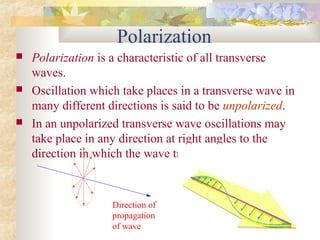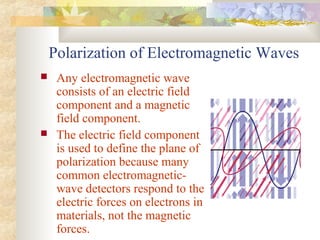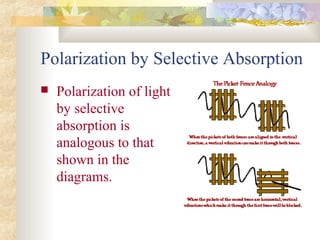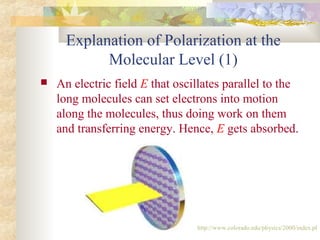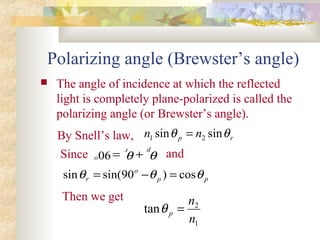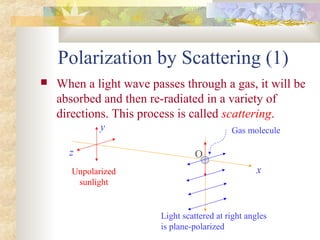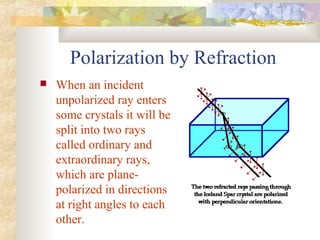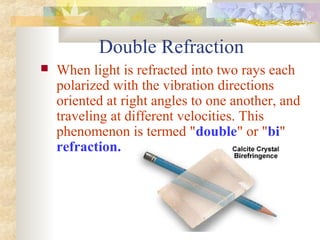Polarization
- 1. Polarization Polarization is a characteristic of all transverse waves. Oscillation which take places in a transverse wave in many different directions is said to be unpolarized. In an unpolarized transverse wave oscillations may take place in any direction at right angles to the direction in which the wave travels. Direction of propagation of wave
- 2. Linear Polarization If the oscillation does take place in only one direction then the wave is said to be linearly polarized (or plane polarized) in that direction. Direction of oscillation Direction of travel of wave
- 3. Polarization of Electromagnetic Waves Any electromagnetic wave consists of an electric field component and a magnetic field component. The electric field component is used to define the plane of polarization because many common electromagnetic- wave detectors respond to the electric forces on electrons in materials, not the magnetic forces.
- 4. Polarization by Selective Absorption Polarization of light by selective absorption is analogous to that shown in the diagrams.
- 5. Polaroid A Polaroid filter transmits 80% or more of the intensity of a wave that is polarized parallel to a certain axis in the material, called the polarizing axis. Polaroid is made from long chain molecules oriented with their axis perpendicular to the polarizing axis; these molecules preferentially absorb light that is polarized along their length. Polarizing axis
- 6. Explanation of Polarization at the Molecular Level (1) An electric field E that oscillates parallel to the long molecules can set electrons into motion along the molecules, thus doing work on them and transferring energy. Hence, E gets absorbed. http://www.colorado.edu/physics/2000/index.pl
- 7. Explanation of Polarization at the Molecular Level (2) An electric field E perpendicular to the long molecules does not have this possibility of doing work and transferring its energy, and so passes through freely. When we speak of the axis of a Polaroid, we mean the direction which E is passed, so a polarizing axis is perpendicular to the long molecules.
- 8. Intensity of Light transmitted through a Polarizer (1) An ideal polarizer passes 100% of the incident light that is polarized in the direction of the polarizing axis but completely blocks all light that is polarized perpendicular to this axis. When unpolarized light is incident on an ideal polarizer, the intensity of the transmitted light is exactly half that of the incident unpolarized light, no matter how the polarizing axis is oriented.
- 9. Intensity of Light transmitted through a Polarizer (2) If a beam of plane-polarized light strikes a polarizer whose axis is at an angle of θ to the incident polarization direction, the beam will emergy plane-polarized parallel to the polarizing axis and its amplitude will be reduced by cos θ. θ oEθcosoE Incident beam of Amplitude Vertical Polaroid Transmitted wave θcosoEE =
- 10. Intensity of Light transmitted through a Polarizer (3) A Polaroid passes only that component of polarization that is parallel to its axis. As the intensity of a light beam is proportional to the square of the amplitude, and θcosoEE = Hence the intensity of a plane-polarized beam transmitted by a polarizer is θ2 cosoII =
- 11. Polarization by Reflection Unpolarized light can be polarized, either partially or completely, by reflection. The amount of polarization in the reflected beam depends on the angle of incidence.
- 12. Brewster’s law It is found that experimentally when the reflected ray is perpendicular to the refracted ray, the reflected light will be completely plane-polarized. Reflected ray Inciden t ray o 90 pθ rθ pθ 1n 2n
- 13. Polarizing angle (Brewster’s angle) The angle of incidence at which the reflected light is completely plane-polarized is called the polarizing angle (or Brewster’s angle). By Snell’s law, rp nn θθ sinsin 21 = Since o r p90 = +θ θ and pp o r θθθ cos)90sin(sin =−= Then we get 1 2 tan n n p =θ
- 14. Polarization by Scattering (1) When a light wave passes through a gas, it will be absorbed and then re-radiated in a variety of directions. This process is called scattering. Unpolarized sunlight Gas molecule Light scattered at right angles is plane-polarized O y z x
- 15. Polarization by Scattering (2) Consider a gas molecule at point O. The electric field in the beam of sunlight sets the electric charges in the molecule into vibration. Since light is a transverse wave, the direction of the electric field in any component of the sunlight lies in the yz-plane, and the motion of charges take place in this plane. There is no electric field, and hence no motion of charge in the x-direction.
- 16. Polarization by Scattering (3) The molecule reemits the light because the charges are oscillating. But an oscillating charge does not radiate in the direction of its oscillation so it does not send any light to the observer directly below it. Therefore, an observer viewing at right angles to the direction of the sunlight will see plane- polarized light.
- 17. Polarization by Refraction When an incident unpolarized ray enters some crystals it will be split into two rays called ordinary and extraordinary rays, which are plane- polarized in directions at right angles to each other.
- 18. Double Refraction When light is refracted into two rays each polarized with the vibration directions oriented at right angles to one another, and traveling at different velocities. This phenomenon is termed "double" or "bi" refraction.
- 19. Applications of Polarizations (1) Polaroid sunglasses The glare from reflecting surfaces can be diminished with the use of Polaroid sunglasses. The polarization axes of the lens are vertical, as most glare reflects from horizontal surfaces.
- 20. Applications of Polarization (2) Stress Analysis Fringes may be seen in the parts of a transparent block under stress, viewing through the analyser. The pattern of the fringes varies with the stress.
- 21. Applications of Polarization (3) Liquid Crystal Display (LCD)
- 22. Applications of Polarization (4) VHF and UHF antennas (aerial) Radio waves can be detected either through their E-field or their B-field. Stations transmitted radio waves which are plane-polarized.
- 23. Applications of Polarization (5) Electric field of EM wave produces a current in an antenna consisting of straight wire or rods.
- 24. Applications of Polarization(6) Changing magnetic field induces an emf and current in a loop antenna.
- 25. Blue Sky The blue color of the sky is caused by the scattering of sunlight off the molecules of the atmosphere. This scattering, called Rayleigh scattering, is more effective at short wavelengths
- 26. Sunset As incoming sunlight passes through a more dense atmosphere, shorter wavelengths of light (violet and blue) are efficiently scattered away by particles suspended in the atmosphere. This allows predominantly yellow and red wavelengths of light to reach the observer's eyes, producing a yellowish-red sunset.
- 27. Blue Skies and Red Sunsets As the path which sunlight takes through our atmosphere increases in length, ROYGBIV encounters more and more atmospheric particles. This results in the scattering of greater and greater amounts of yellow light.
- 29. Liquid Crystal Liquid crystal is a substance that behaves something like a liquid and something like a solid. The shape of its molecules are long and thin.
- 30. Properties of LCD Their orientations can be aligned with one another in a regular pattern. A particular sort of liquid crystal, called twisted nematics, (TN), is naturally twisted. Applying an electric current to these liquid crystals will untwist them to varying degrees, depending on the current's voltage.
- 31. Twisted Nematics They can rotate the plane of oscillation of polarized light passing through them. Light passes through the cell with its plane of polarization turned through 90° Light cannot pass through since the line does not rotate the plane of polarization
